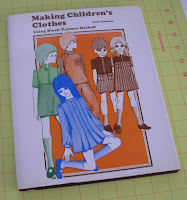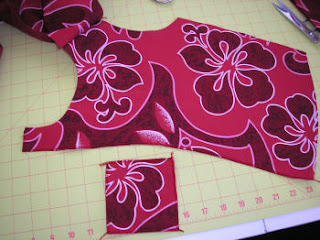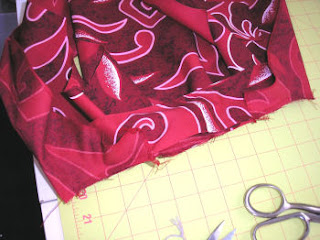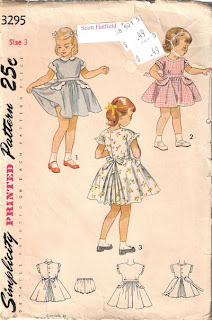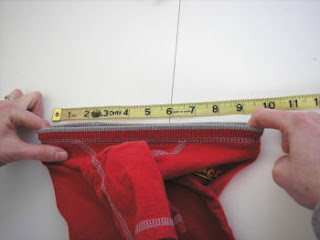
I am going to try and get back to my grading explanations today. My head is a bit fuzzy after a long week and an especially late night. To review, just click on the grading category link to the right. Click on the picture for a bigger view.
The diagram on the left shows three possible grading examples. This is a basic front bodice pattern piece that is folded in half. Each example is called a
nest meaning each size is stacked on top of each other from smallest to largest. The stars represent the point of origin for each grade. The numbers at each point correspond to a grade rule. I will briefly explain each of these items below.
By laying your graded patterns on top of each other in a nest, you can easily see if your pattern is grading proportionally. The stars not only show the point of origin, but the stack point. You can stack your patterns in three general areas and have the grade look different each time. In computerized grading, you can move your stack point anywhere you choose and the grading software will update your grades automatically. For consistency's sake, it is important to determine before you start grading where your stack point/grading point of origin will be.
Each stack point will cause your grading to look different. Most of the grading world uses Example 1. The point of origin is placed in the center of the pattern pieces and growth occurs in all directions. In Example 2, the stack point is placed at the center front waistline and growth occurs to the side and upwards to the neck. Example 3 is the same result as 2, but placed at the center front neck.
I prefer Example 3 and all of my patterns are generally graded this way. It makes the most sense to me and the grade rules are simpler. Most of the proportional changes between sizes occur this way in nature. A person's neck doesn't actually move upward in each size, but rather their waist moves down. Perhaps this is just how my mind works. In any event, you can choose which ever point makes the most sense to you.
I have been using the term
grade rules rather loosely in my previous grading articles. Grade rules refer to measurement charts broken down into
grade steps. Grade rules can also refer to the actual change that occurs at a point. In the drawings above, I have numbers assigned to each point. Those numbers can refer to a grade rule. For example:
Rule X,Y changes
- 0, 0
- 1/8, 1/8
You can create a chart like the one above, if you prefer. This method is used in computerized grading and each grade rule is placed in a grade library (specific to a size range). Once a style is ready to grade, you simply apply a rule to each point and the pattern pieces will stay graded regardless of pattern changes. It is less helpful when hand grading and may make things more complicated. To be honest, I rarely use grade libraries when computer grading. They can speed things up if you have consistently similar styles. However, things always need tweaking, so I prefer to manually manipulate the grade at each point. Most grading software will allow you to assign a grade rule from a library and still manually edit the point. The computer will begin a grade command by starting with rule #1 and working around through each point. Rule 1 is almost always set as (0,0) and it should always be your stack point.
When hand grading, you should start your grading at your stack point. Once that is set, you then move to the next point, say the neck-shoulder point and mark all of the changes there. Work counter-clockwise (or vice versa, if you choose), around to each point. Setting up a consistent method will help you keep things straight.
Ok. Enough explanation. Decide on your stack point and get ready to grade.
 This is a basic skirt block for a girl's size 10. A style line is drawn on the pattern where the gather detail is to be placed.
This is a basic skirt block for a girl's size 10. A style line is drawn on the pattern where the gather detail is to be placed. Lines are drawn from the dart point and the style line until they intersect. The skirt is slashed along those lines to the point of intersection. The dart is partially rotated closed. The original style had some fullness in the waist. The dart equivalent fullness only adds about a 1/2" to the waist front. I suspect the original style had more. The original style was probably for an older teenager rather than a young girl. Anyway, slash lines are drawn from the lower dart leg to the hip line (On a full length skirt, the slash lines would go to the hem. For ease, I am only working to the hip line).
Lines are drawn from the dart point and the style line until they intersect. The skirt is slashed along those lines to the point of intersection. The dart is partially rotated closed. The original style had some fullness in the waist. The dart equivalent fullness only adds about a 1/2" to the waist front. I suspect the original style had more. The original style was probably for an older teenager rather than a young girl. Anyway, slash lines are drawn from the lower dart leg to the hip line (On a full length skirt, the slash lines would go to the hem. For ease, I am only working to the hip line).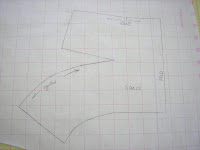 Slash the skirt along the new slash lines to the hip and spread to the desired fullness. In this case, I spread for a 2:1 gather ratio. The finished pattern would look something like the one to the left. Like I said, I forget to add seam allowances to the dart opening. If you try this yourself, don't forget to add them.
Slash the skirt along the new slash lines to the hip and spread to the desired fullness. In this case, I spread for a 2:1 gather ratio. The finished pattern would look something like the one to the left. Like I said, I forget to add seam allowances to the dart opening. If you try this yourself, don't forget to add them.



